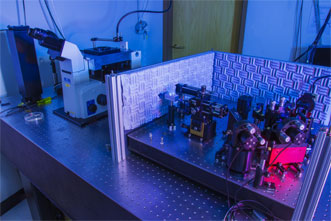Stable enough to track the movements of individual molecules over many hours, a new measurement platform for microscopes could enable a deeper understanding of subcellular processes.
The technology was designed to track single base pairs in human DNA but could be useful in manufacturing, according to researchers at JILA, a partnership between the National Institute of Standards and Technology (NIST) and the University of Colorado Boulder.
"This technology can actively stabilize two items relative to each other with a precision well below one nanometer at room temperature," said physicist Tom Perkins. "This level of 3D stability may start to interest the nanomanufacturing world, when they look at making and characterizing things on the single-nanometer scale."

A microscopy platform uses two lasers to take ultrastable measurements of subcellular objects over extended periods. The microscope is on the left. The sample is mounted on the black block on top of the silver stage. The lasers and optics are on the right. Courtesy of Steven Burrows/JILA.
The method uses two lasers to measure the positions of opposite ends of a molecule, or two different objects, based on the intensity of scattered light. The scattered light is detected by a common photodiode, and the signals are digitized, analyzed and used to calculate the positions of the samples.
The JILA team verified the stability of the technique by using the two lasers to make two separate, independent measurements of a single sample. Without this confirmation, researchers can't determine if it is the sample or the lasers moving, Perkins said.
With longer observation times, researchers can see more successive steps of molecular motors, for instance. These biochemical processes are responsible for a broad range of movement in living organisms, including moving molecules around the interior of a cell or copying DNA into RNA. The JILA instrument also can aid in measuring individual proteins as they fold into specific positions, a process required for them to work properly.
Until now, researchers have had difficulty detecting more than a few individual, one-base-pair steps in succession before instrumental "drift" would blur the signal.
Observing such sets of repetitive steps is very rare. The instrument must be stable to within about 1 angstrom, and a microscope typically can achieve this level of stability only occasionally.
Using the new measurement platform, the JILA team reported maintaining 1-Å stability over 1000 seconds and a 1-nm stability over 15 hours, in three dimensions. And it can do this over and over again for extended periods.
In addition to its high precision and stability, the instrument can detect motion over a wide range of time scales, which is critical for calibrating instruments and measuring short-lived states in protein folding.
The JILA method can be applied to optical-trapping techniques, atomic force microscopes and superresolution imaging.
Funding came from the National Science Foundation and NIST.
The research was published in Optics Express (doi: 10.1364/OE.23.016554 [open access]).
For more information, visit jila.colorado.edu.